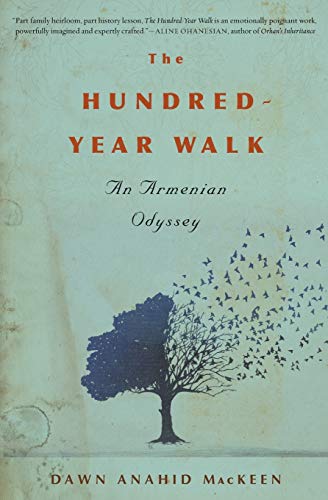The Hundred-Year Walk
April 24 is Armenian Genocide Remembrance Day. The 1.5 million Armenians who perished in the genocide are often an abstract statistic, but a powerful new book, based on the journals of the author's grandfather who lived through the atrocity, may help change that. Houghton Mifflin Harcourt
Houghton Mifflin Harcourt
“The Hundred-Year Walk: An Armenian Odyssey” A book by Dawn Anahid MacKeen To see long excerpts from “The Hundred-Year Walk” at Google Books, click here.
For over 40 years, I have been teaching about the Armenian Genocide in my university classes. The students’ reactions are entirely predictable: Armenian-Americans invariably thank me for mentioning the subject; other students usually know little or nothing about the topic, a tragic result of inadequate American education and continuing Turkish denial about the first genocide of the 20th century. For the latter group of students, I recommend various readings, especially the works of my longtime UCLA colleague, professor Richard Hovannisian, a renowned scholar of this dark episode of human history. But most academic works are intended primarily for scholars and researchers; most students are unlikely to follow up on my suggestions.
I regularly inform students that a million and a half Armenians perished during the genocide, which began in April 1915. But this number, like the 6 million Jews murdered during the Nazi Holocaust, is a remote abstraction. Such huge figures are seemingly devoid of real human drama, especially as these tragedies recede into history. A more fruitful educational alternative for lay audiences, including university students, is often survivor memoirs. These exist in abundance for the Holocaust, but most Armenian Genocide memoirs are in the Armenian language and inaccessible to most Americans.
A new book by journalist Dawn Anahid MacKeen has dramatically changed this. “The Hundred-Year Walk” is a compelling book that chronicles the harrowing experiences of the author’s grandfather during the genocide. Stepan Miskjian was a young man from the town of Adabazar (now Adapazari), located in northwestern Turkey. Although not well educated, he was nevertheless a successful small entrepreneur with extremely close ties to his family. Miraculously, through personal guile, artful manipulation and sheer luck, Miskjian defied the overwhelming odds and survived the death marches that he and his fellow Armenians endured.
Fortunately, he had an extraordinary memory and an amazing capacity (and will) to record all the horrific things that happened to him and his fellow Armenians. That included, among other things, the names of many of the other deportees, the names of some of his tormentors, and the names of the towns that the victims were forced to pass through, in most cases, on the way to their deaths. He compiled these recollections into six carefully written journals about his life before, during and after the Armenian Genocide of 1915.
These journals are the foundation for this remarkable book, part personal memoir and part travel reportage. MacKeen devoted several years to this project, leaving her life in New York to rejoin her mother (Miskjian’s daughter) in Los Angeles. There, she drew on the close Armenian community to translate her grandfather’s journals. Then, she decided to retrace Miskjian’s march by traveling first to Turkey and then to Syria. Both stories result in the parallel narratives in “The Hundred-Year Walk.”
Miskjian’s journey is the most compelling feature of the volume, but it is no easy read. It is a relentless parade of harrowing details. Like all genocide and holocaust stories, this one is a window into the grotesque cruelty that human beings are capable of inflicting on other human beings as they attempt to push them out of the human family (Armenians, Jews, Roma, Indonesians, Rwandans, Cambodians, Sudanese and so on, making the 20th century the bloodiest, most horrifying in human history). His granddaughter skillfully and insightfully reconstructs Miskjian’s vivid depiction of the torment that he and his compatriots endured during their forced marches into the desert.
The Ottoman government, using the malevolent falsehood that Armenian Christians had sided with the enemy during World War I, ordered Miskjian’s family and other Armenians from their homes in Adabazar and elsewhere. They endured mass shootings, burnings, drownings, beatings, torture, rape (including young girls), and severe hunger. Thousands — women, men, and children alike –died along the way, by conscious design of their Ottoman oppressors. Many details in the book are almost too graphic to contemplate; yet the historical record demands the full truth as this book so effectively and devastatingly reveals.
When people are forced to the edge of desperation, they will do whatever it takes to survive for a few more days or even hours. In perhaps the most chilling episode of Miskjian’s journal, he recounts a scene where he found four girls and a woman. He watched them carve up the body of an elderly female, cooking portions of the dead woman’s leg and inserting the flesh into their mouths. Miskjian, astonished, asked them if they knew what they were doing. Their reply was perfectly understandable yet thoroughly unnerving under the circumstances: “What can we do to not die of hunger?”The starvation and thirst that Miskjian witnessed are the most poignant features of this entire book. His haunting descriptions of hungry, thirsty and naked fellow human beings, reduced literally to skin and bones, dying slowly on the desert, are unbearable. Forbidden to take a drink or eat more than a handful or two of grain, they exemplified the grotesque essence of the Armenian Genocide. That reality, more than numbers alone, should be the indelible memories created for readers by this powerful volume.
Throughout this ordeal, Miskjian repeatedly disguised himself, outmaneuvered and hid from police and guards, and sought to blend into whatever local populations he encountered during the death marches. Eventually, and miraculously, he found refuge with a powerful Arab sheikh who defied the hostility against Armenians and gave him shelter, food, clothing and employment. Like the (all too few) “righteous gentiles” of the Nazi era, the sheikh ignored religious and cultural differences and saved Miskjian’s life. Eventually, Miskjian returned to his hometown to reunite with his surviving family. He re-established his life, eventually immigrating to the United States. Without the help of the sheikh, four generations of his family would not exist.
The parallel story, expressed in alternate chapters throughout the book, is the author’s personal journey — really an obsession — to retrace her grandfather’s perilous journey through the deserts of Turkey and Syria. She is candid about her motivation: “I needed to taste his thirst, touch the land where he walked. See the green hills surrounding his Adabazar, where his dreams of becoming the town’s first courier had taken root, before they withered and died in the desert.”
In 2007, MacKeen hired a translator and journeyed to Turkey and then Syria. Both countries involved risks and dangers for her. Being of Armenian descent is still problematic in Turkey. Nevertheless, many individuals in that country treated her with genuine kindness, despite the official policy of the government to deny the genocide of 101 years ago.
In Syria, under the tyrannical regime of Bashar Assad, she was followed and questioned by the dictator’s secret police. Still, she managed to find the family of the Arab sheikh who saved Miskjian’s life. She was enthusiastically welcomed there and treated as though she were a returning family member. Ironically, however, her visit occurred in the Syrian city of Raqqa, which a century ago was a safe haven for Armenians but is now the headquarters of the murderous ISIS, the so-called Islamic State that engages in horrific terrorism and that proudly videotapes and disseminates its beheadings of “infidels.”
“The Hundred-Year Walk,” beyond its unforgettable stories of the author and her grandfather, has enormous implications for contemporary public policy. Above all, civilized nations throughout the world must vigorously confront the continuing Turkish denial of the Armenian Genocide. That denial, which involves active campaigns against recognition of the Genocide and overt lies and distortions in its educational and media institutions, has been rightly and widely condemned.
Pope Francis, to his everlasting moral credit, used the word “genocide” last year in remarks at the Vatican. It would behoove President Obama, in his final year in office, to fulfill his promise to use the same word to describe the atrocities that befell the Armenian people. Perceived geopolitical benefits of U.S. alliances with Turkey should never give way to moral decency and historical truth. Armenians need full recognition for their incalculable suffering during the genocide. But humanity more generally should demand a full accounting of all historical crimes, no matter the perpetrators and how long the denial.
More than a century after the Armenian Genocide, the world is now confronting a refugee crisis of comparable gravity. Since the start of the Syrian civil war, millions of displaced Syrians have sought refuge throughout the world, including in Turkey, Lebanon, Jordan and various European nations. Images of bedraggled men, women and children have pervaded the media; and some pictures of starving and dead infants and young children have become iconic symbols of early 21st century human suffering and horror. They are eerily reminiscent of the Armenian refugees on their death marches chronicled in MacKeen’s book and illustrated photographically in the Genocide Museum in Yerevan, Armenia.
Some European countries like Germany have demonstrated strong humanitarian commitments by providing asylum for many thousands of these displaced persons. But their presence has also generated a frightening xenophobic backlash, from nationalistic governments like Hungary and protests from resurgent right-wing and neo-Nazi groups throughout the European continent.
Similar responses have found expression in the United States, from the racist anti-Muslim rants of Republican presidential candidate Donald Trump to the large number of governors, mostly Republicans, promising to do whatever they can to prevent Syrian refugees from entering their states. All of this is tragically similar to the attitudes and actions that precipitated the Armenian Genocide.
This book is a timely warning that we cannot allow any group of people to be marginalized as The Other, to be allowed to suffer egregiously in the face of massive world indifference. Dawn Anahid MacKeen has done her readers, and history, a profound service. It remains only for people of goodwill to ensure that her grandfather’s story not be forgotten and that they act to mitigate the genocides of the present and prevent the genocides of the future. This, sadly, will be a monumental undertaking.
Your support matters…Independent journalism is under threat and overshadowed by heavily funded mainstream media.
You can help level the playing field. Become a member.
Your tax-deductible contribution keeps us digging beneath the headlines to give you thought-provoking, investigative reporting and analysis that unearths what's really happening- without compromise.
Give today to support our courageous, independent journalists.




You need to be a supporter to comment.
There are currently no responses to this article.
Be the first to respond.